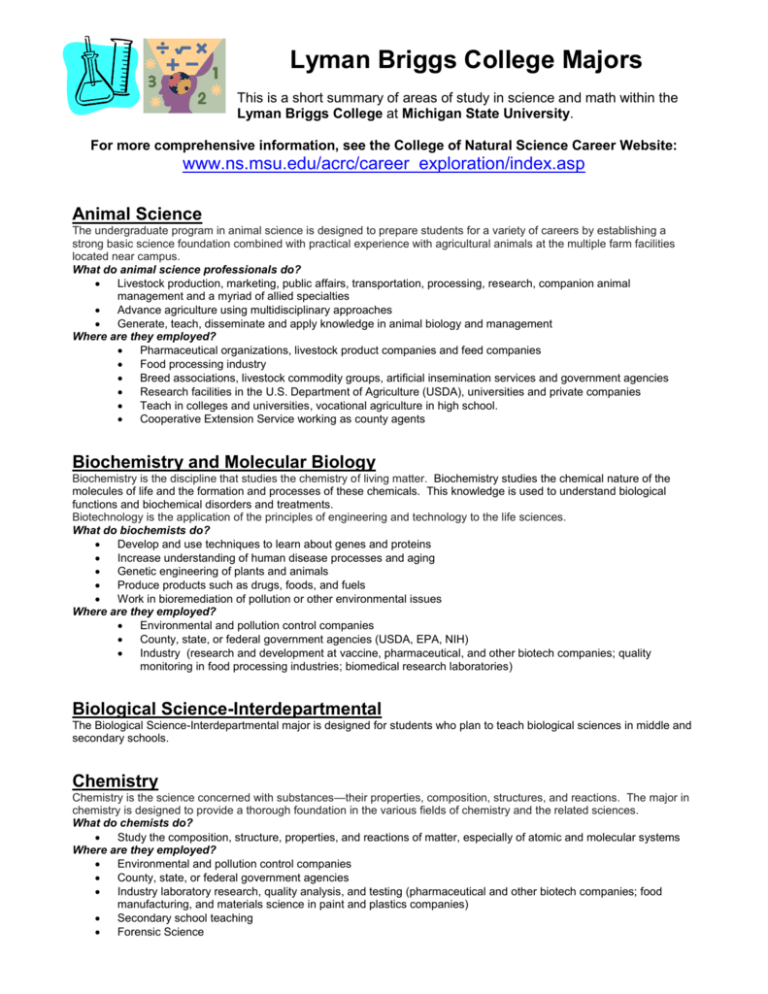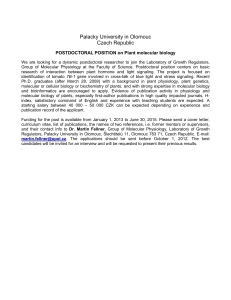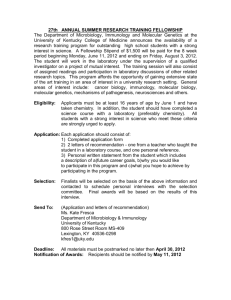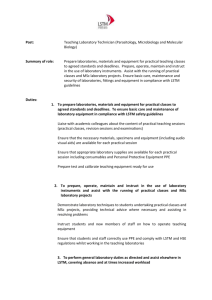ScienceAndMathMajorsFS08
advertisement

Lyman Briggs College Majors This is a short summary of areas of study in science and math within the Lyman Briggs College at Michigan State University. For more comprehensive information, see the College of Natural Science Career Website: www.ns.msu.edu/acrc/career_exploration/index.asp Animal Science The undergraduate program in animal science is designed to prepare students for a variety of careers by establishing a strong basic science foundation combined with practical experience with agricultural animals at the multiple farm facilities located near campus. What do animal science professionals do? Livestock production, marketing, public affairs, transportation, processing, research, companion animal management and a myriad of allied specialties Advance agriculture using multidisciplinary approaches Generate, teach, disseminate and apply knowledge in animal biology and management Where are they employed? Pharmaceutical organizations, livestock product companies and feed companies Food processing industry Breed associations, livestock commodity groups, artificial insemination services and government agencies Research facilities in the U.S. Department of Agriculture (USDA), universities and private companies Teach in colleges and universities, vocational agriculture in high school. Cooperative Extension Service working as county agents Biochemistry and Molecular Biology Biochemistry is the discipline that studies the chemistry of living matter. Biochemistry studies the chemical nature of the molecules of life and the formation and processes of these chemicals. This knowledge is used to understand biological functions and biochemical disorders and treatments. Biotechnology is the application of the principles of engineering and technology to the life sciences. What do biochemists do? Develop and use techniques to learn about genes and proteins Increase understanding of human disease processes and aging Genetic engineering of plants and animals Produce products such as drugs, foods, and fuels Work in bioremediation of pollution or other environmental issues Where are they employed? Environmental and pollution control companies County, state, or federal government agencies (USDA, EPA, NIH) Industry (research and development at vaccine, pharmaceutical, and other biotech companies; quality monitoring in food processing industries; biomedical research laboratories) Biological Science-Interdepartmental The Biological Science-Interdepartmental major is designed for students who plan to teach biological sciences in middle and secondary schools. Chemistry Chemistry is the science concerned with substances—their properties, composition, structures, and reactions. The major in chemistry is designed to provide a thorough foundation in the various fields of chemistry and the related sciences. What do chemists do? Study the composition, structure, properties, and reactions of matter, especially of atomic and molecular systems Where are they employed? Environmental and pollution control companies County, state, or federal government agencies Industry laboratory research, quality analysis, and testing (pharmaceutical and other biotech companies; food manufacturing, and materials science in paint and plastics companies) Secondary school teaching Forensic Science Computer Science Computer science encompasses the broad areas of information processing and problem solving using digital computers. Students learn to analyze, design, and build integrated software and hardware digital systems that process, transmit, and reason about information in order to solve problems. What do computer scientists do? Analyze problems and select appropriate paradigms to solve them Design and implement software Manage system resources Where are they employed? Companies in need of web design, computer networking, game design, cognitive science, telecommunications, etc. Research facilities focusing on software engineering, biometrics, image processing, robotics, etc. Industry University, College, and Secondary school teaching Museums and Universities as research faculty Entomology Entomology is the field of biological science concerned with the study and management of beneficial and harmful insects and their relatives in relation to other animals, plants, and the environment. What do entomologists do? Study and manage insects’ and their relatives’ effects on human activities Manage non-agricultural, long-term aquatic and terrestrial ecosystems Study interactions of insects and their relatives with economic plants and sustainable agriculture Where are they employed? Nature organizations Educational Institutions Forensic Laboratories Agricultural Organizations Environmental Sciences General Environmental Science degree sampling from the areas of Ecology, Geology, Biochemistry, Aquatic Systems, Microbiology, conservation, and Taxonomy or Phylogenetic Biology, and ecosystem management. Environmental scientists conduct research to identify and abate or eliminate sources of pollutants or hazards that affect people, wildlife, and their environments. What do environmental scientists do? Improve the natural environment and address effects of human activity on the environment Address concerns of soil fertility, water purity, food supply quality and safety, natural resources, pollution, plants climate change, etc. Increase knowledge about the physical and biological environment and natural disasters Where are they employed? Nature organizations Environmental Impact Firms Environmental and pollution control companies County, state, or federal government agencies Industry (oil, mineral, natural gas, and water exploration and mining) Museums and Universities as research faculty Geological Sciences The biological, chemical, isotopic, and physical aspects of the Earth are all integrated into the geological sciences, which draw heavily on all of those other sciences, as well as mathematics and statistics. Geological studies provide knowledge concerning the availability of natural resources, including groundwater and fossil fuels; the reduction of damage from such hazards as landslides and earthquakes; and processes affecting biological evolution, such as those producing major extinctions. From these diverse studies geologists gain knowledge about the controls on the physical and biological environment. What do geological scientists do? Use their knowledge of the physical makeup and history of the Earth to locate water, mineral, and energy resources, protect the environment, predict future geologic hazards, and offer advice on construction and land use projects Geoscience disciplines are geology, paleontology, geochemistry, mineralogy, hydrology, environmental science, and soil science Where are they employed? Environmental and pollution control companies County, state, or federal government agencies (NOAA, NRCS, USGS, etc.) Industry (oil, mineral, natural gas, and water exploration and mining) Secondary school teaching Museums and Universities as research faculty History, Philosophy and Sociology of Science History, Philosophy, and Sociology of Science courses bridge the natural and physical sciences with the social sciences and humanities. HPS courses are offered in four overlapping substantive areas: science, technology, the environment, and medicine. In such classes, students examine numerous empirical, conceptual, and theoretical issues related to these substantive areas, using historical, philosophical, and sociological perspectives and methods. What do HPS scientists do? Use their knowledge to improve the historical, philosophical, and sociological understanding of science, technology, the environment, and medicine Examine numerous empirical, conceptual, and theoretical issues related to these substantive areas, using historical, philosophical, and sociological perspectives and methods Where are they employed? Public policy agencies and law firms Research County, state, or federal government agencies Industry Education Museums and Universities as research faculty Human Biology The Human Biology major is an interdisciplinary science degree, suitable for students who want a broad background in biological science and want to understand the interrelationships among fields. It can be used mainly as a foundation to pursue medical, dental, and veterinary school paths. Mathematics Mathematics, which may partially be defined as the science of number and form, is a vital tool in all branches of knowledge. Mathematics is also studied for its own sake by those who become fascinated by the results of modern mathematics and the making of new discoveries. What do mathematicians do? Use mathematical modeling and computational methods to formulate and solve practical problems in business, government, engineering, and in the physical, life, and social sciences Where are they employed? Industry – process design, traffic analysis, electric power routing, inflation statistics, computer software design Business – Actuaries, financial analysts, insurance underwriters, budget analysts, market research Federal government – Cryptology, data mining, and other advanced mathematics Secondary school teaching Medical Technology/Clinical Laboratory Science/ Diagnostic Molecular Science The Biomedical Laboratory Diagnostics Program offers three undergraduate degree programs to assist students in entering the exciting, hi-tech world of the clinical laboratory. Clinical laboratory science traditionally called medical technology, is the health profession focused on the provision of high quality medical laboratory tests on blood and body fluids. Diagnostic molecular science is the allied health profession whose practitioners specialize in performing medical laboratory tests on DNA and RNA. What do they do? Clinical Laboratory Scientists/Medical Technologists (terms are synonymous) are scientists who apply their knowledge to perform diagnostic tests on blood and body fluids. The sub-disciplines include, but are not limited to, clinical chemistry, hematology, immunology, immunohematology and microbiology. Diagnostic Molecular Science is a subdiscipline of laboratory science emerging as a separate laboratory profession whose practitioners perform molecular diagnostic techniques for medical diagnosis of acquired or inherited diseases as well as forensic testing. Where are they employed? Hospitals or private laboratories Federal, state, and local health departments Commercial and academic biomedical research laboratories Forensic laboratories Medical and scientific sales, laboratory consulting, and medical laboratory education Microbiology and Molecular Genetics Microbiology involves the study of microscopic organisms: bacteria, viruses, algae, fungi, and protozoa, as well as animal and plant cells in culture. Microbiology also includes research on the interaction of pathogenic and symbiotic microbes with their hosts and the host response to infection. Molecular genetics and genomics includes study of the basis of heredity and the mechanisms by which genes exert their effects. What do microbiologists do? A microbiologist is a scientist who studies living organisms and infectious agents, many of which can only be seen with a microscope. They may focus on findings critical to health, agriculture, environmental sciences, or how living systems function at the molecular level. Where are they employed? Environmental and pollution control companies County, state, or federal government agencies (NIH, USDA, EPA, etc.) State departments of health or public health Industry – Research in diagnostic labs, vaccine companies, pharmaceutical companies. Product safety for products such as cosmetics, food, and egg and dairy industries. Research and development and quality control for food companies. Commercial and academic biomedical research laboratories Nutritional Science Nutritional science explores the science of nutrition and the relationships between nutrients and human health. Most research, public health, and clinical nutrition positions require a graduate degree. Jobs in industry and food service management are common; course work in food science and business is helpful. Physics Physics is the study of the physical universe. By means of observation, experiment, theoretical constructions and computer simulations, this science attempts to find the principles, which describe that universe. Among the topics of physics are motion and force, energy, sound, electricity and magnetism, light, atomic and nuclear structure, nuclear reactions, properties of condensed matter, the elementary particles and their interactions, and particle accelerators. What do physicists do? Explore and identify basic principles governing the structure and behavior of matter and the interaction of matter and energy Where are they employed? Research – government and private industries Technical sales Optics or industrial labs Radiation monitoring, electrical power plants Health - nuclear medicine, radiation therapy Secondary school teaching Physical Sciences - Interdepartmental The Physical Science-Interdepartmental major is designed for students who plan to teach physical sciences in middle and secondary schools. Physiology Physiology studies life processes, both in the whole organism and at cellular and molecular levels. Most professionals in physiology hold a Ph.D. Anyone aspiring to be an independent investigator in physiology should plan to obtain a graduate or an MD degree. For this reason, individuals interested in physiology careers should give careful consideration to graduate study. Plant Biology The field of plant biology, also referred to as botany, concerns itself with the study of the structure, function, evolution, distribution, and classification of plants. The physiological, molecular, and biochemical mechanisms; systematics; development; inheritance; ecology; and geological history of plants are areas of plant biology pertinent to solving problems fundamental to all living organisms. What do plant biologists do? Study the form, function, diversity, reproduction, and uses of plants and their interactions within the biosphere. Ecologists, botanists, and taxonomists can be plant biologists, as well as plant pathologists. People working with algae and fungi are often trained as or called plant biologists (even though, technically, those groups aren’t plants). Where are they employed? Environmental and pollution control companies County, state, or federal government agencies (USDA, NRCS, Forest Service, etc.) Secondary school teaching Nature organizations and Public botanical gardens Agricultural industries Statistics and Probability Statistics is the study of methods of drawing inferences from sets of data. What do statisticians do? Statistics includes planning for the collection of data, data management, drawing conclusions from data, and presentation of results. Using statistics, many businesses make projections from small samples to larger processes—for example: forecasting sales in business; predicting the effectiveness of new drugs; or determining insurance rates. Where are they employed? Federal, state, and local government (IRS, CIA, USDA, NIH, etc.) Public health and medicine (as epidemiologists or biomathemeticians) Business and Industry as actuaries or budget analysts Scientific, environmental, and agricultural companies to help identify patterns in data Zoology Zoology is the branch of natural science that deals with animal biology. It is concerned with every level of biological organization from the gene to the ecosystem, and with the structure, physiology, behavior, genetics, development, distribution, and evolution of animals in all taxonomic groups. What do zoologists do? Study life at the level of the cell, organism, population, community, and/or ecosystem. Ecologists, marine biologists, taxonomists, wildlife and fisheries biologists, and others are examples of zoologists. Where are they employed? County, state, and federal agencies – in research or regulation and enforcement of environmental laws Industry – such as monitoring effluent production and land use around a factory and measure environmental health Zoos – as animal caretakers or zookeepers Environmental Educators at Nature Centers or Museums





